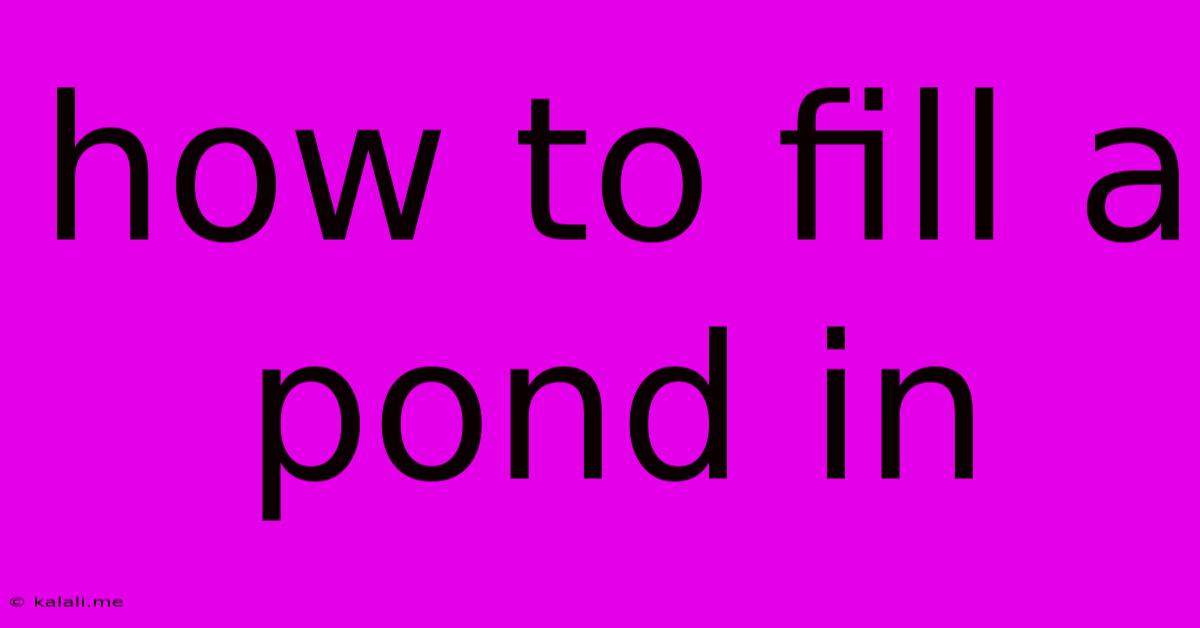How To Fill A Pond In
Kalali
May 21, 2025 · 3 min read

Table of Contents
How to Fill a Pond: A Comprehensive Guide
Meta Description: Learn how to properly fill your new pond, from choosing the right water source to preventing cloudy water. This guide covers everything you need to know for a healthy pond ecosystem.
Creating a beautiful and thriving pond requires careful planning, and filling it correctly is a crucial first step. This guide walks you through the process, covering everything from selecting your water source to maintaining water quality. Let's dive in!
Choosing Your Water Source
The best water source for your pond depends on several factors, including your location, budget, and the size of your pond.
-
Tap Water: The easiest option, but often contains chlorine and chloramine, which can harm aquatic life. You'll need a dechlorinator to neutralize these chemicals before adding the water to your pond. This method can be expensive for large ponds.
-
Well Water: Usually free from chlorine and chloramine, but may contain high levels of minerals or other impurities that could affect water quality and plant health. Testing your well water is crucial before using it.
-
Rainwater: The most environmentally friendly option, providing naturally soft water ideal for most pond ecosystems. However, it relies on rainfall and may not be sufficient for quickly filling a large pond. Consider using a rainwater harvesting system for a consistent supply.
-
Pond Water from Another Source: If you’re creating a new pond and have access to established, healthy pond water, this is the best option as it will help establish beneficial bacteria.
The Filling Process
Once you've chosen your water source and treated it accordingly (dechlorination for tap water, testing for well water), you can begin filling your pond.
-
Start Slowly: Avoid rapidly filling the pond, as this can cause erosion and damage to the liner or pond structure. A slow, steady fill allows the pond to settle.
-
Monitor Water Levels: Regularly check the water level and adjust the flow rate as needed to maintain a consistent fill. It's better to fill it gradually over several days or even weeks to allow the soil to settle.
-
Prevent Overflow: Ensure your pond has a proper overflow system to prevent flooding. Regularly check the overflow during filling.
-
Water Quality Testing: Before adding any plants or fish, test the water quality using a pond testing kit. This will help identify any potential problems early on. Key parameters include pH, ammonia, nitrite, and nitrate levels.
Maintaining Water Clarity
Cloudy water is a common problem in newly filled ponds. Here's how to maintain clarity:
-
Beneficial Bacteria: Adding beneficial bacteria is crucial to breaking down waste products and maintaining water quality. These bacteria help establish a healthy pond ecosystem.
-
Water Filtration: Installing a pond filter can significantly improve water clarity by removing debris and algae. Consider the size of your pond when choosing a filter.
-
Planting: Aquatic plants play a vital role in filtering nutrients and oxygenating the water, contributing to clearer water. Select plants suited to your pond's size and depth.
-
Avoid Overfeeding Fish: Overfeeding fish leads to excess waste, which clouds the water and damages water quality. Feed fish only what they can consume within a few minutes.
Conclusion
Filling your pond correctly is essential for creating a healthy and aesthetically pleasing environment. By following these steps and considering the factors discussed, you can ensure your pond thrives for years to come. Remember, patience and careful monitoring are key to a successful pond creation.
Latest Posts
Latest Posts
-
Is Warhammer And Warhammer 40k Connected
May 21, 2025
-
When Yom Kippur Falls On Shabbat
May 21, 2025
-
How Do You Kill A Hydra
May 21, 2025
-
As Good As It Gets Meaning
May 21, 2025
-
South Park The Stick Of Truth Homeless
May 21, 2025
Related Post
Thank you for visiting our website which covers about How To Fill A Pond In . We hope the information provided has been useful to you. Feel free to contact us if you have any questions or need further assistance. See you next time and don't miss to bookmark.